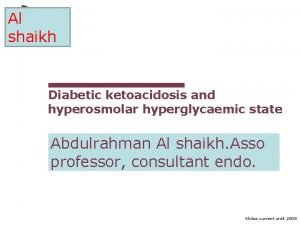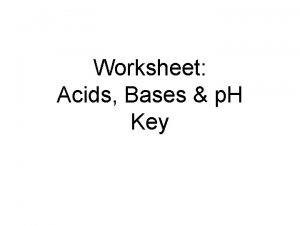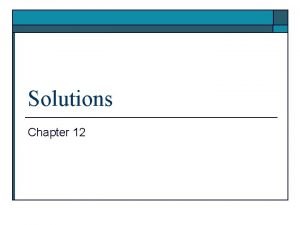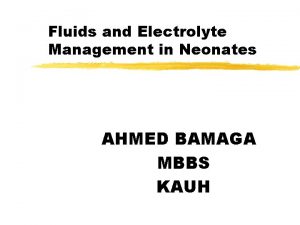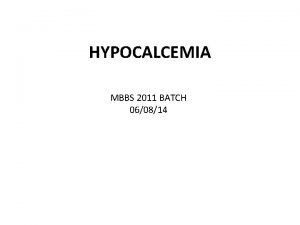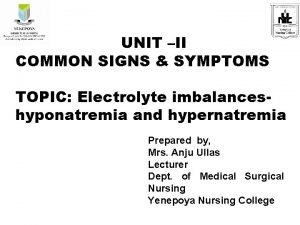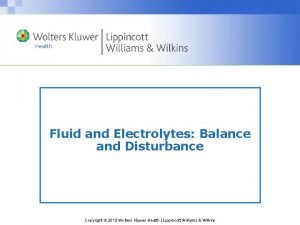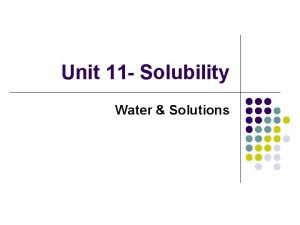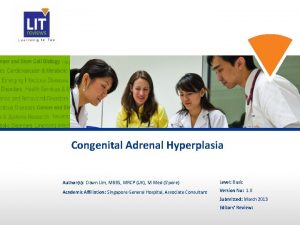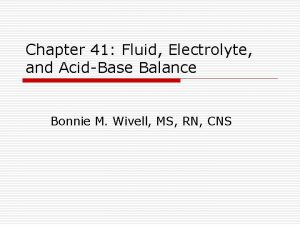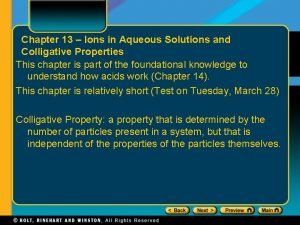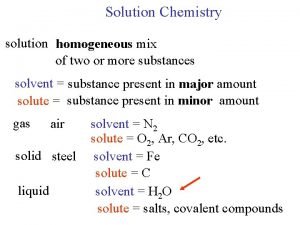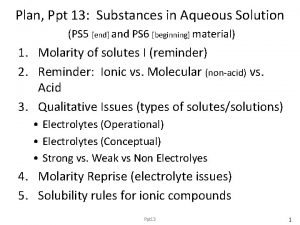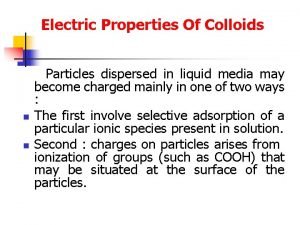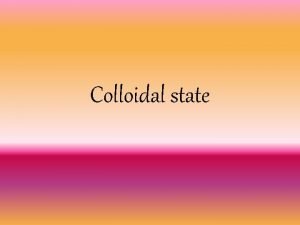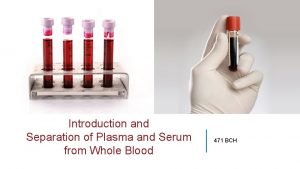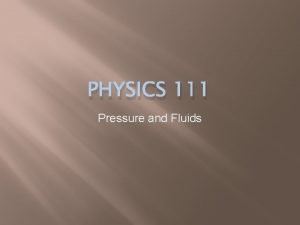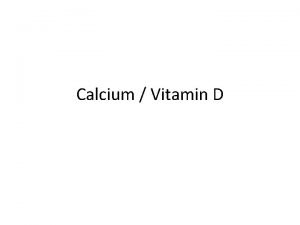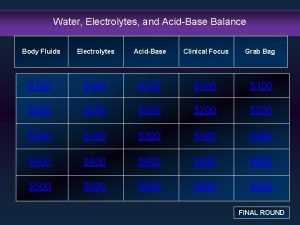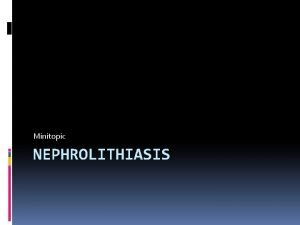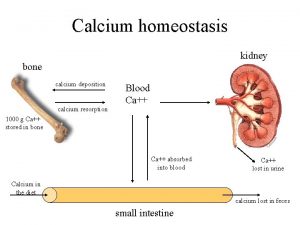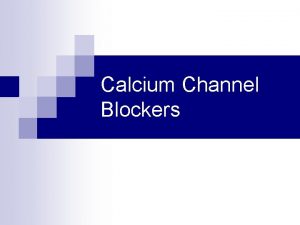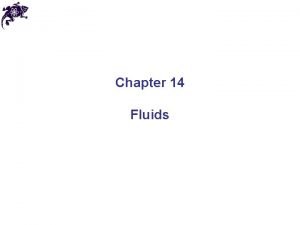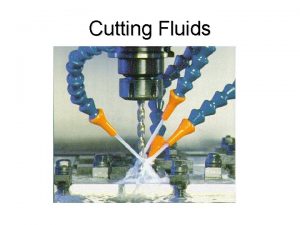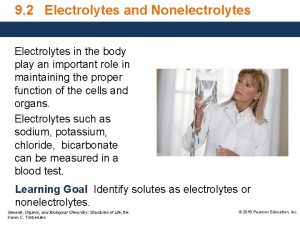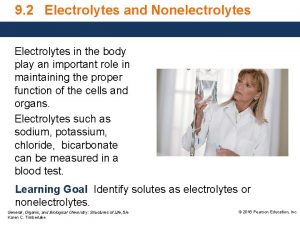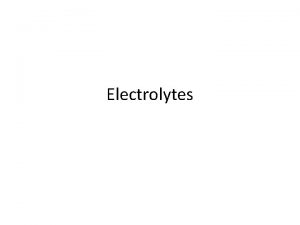FLUIDS AND ELECTROLYTES HYPOCALCEMIA DESCRIPTION A serum calcium














































- Slides: 46

FLUIDS AND ELECTROLYTES

HYPOCALCEMIA • DESCRIPTION – A serum calcium level below 8. 6 mg/d. L – The normal serum calcium level is 8. 6 to 10. 0 mg/d. L

HYPOCALCEMIA • CAUSES – Inhibition of calcium absorption from the GI tract • Inadequate oral intake of calcium • Lactose intolerance • Malabsorption syndromes such as celiac or Crohn’s disease • Inadequate intake of vitamin D • End-stage renal disease

HYPOCALCEMIA • CAUSES – Increased calcium excretion • Renal failure, polyuric phase • Diarrhea • Steatorrhea • Wound drainage, especially GI

HYPOCALCEMIA • CAUSES – Conditions that decrease the ionized fraction of calcium • Hyperproteinemia • Alkalosis • Medications such as calcium chelators or binders • Acute pancreatitis • Hyperphosphatemia • Immobility • Removal or destruction of the parathyroid glands

HYPOCALCEMIA • ASSESSMENT – Cardiovascular • Decreased myocardial contractility and heart rate • Hypotension • Diminished peripheral pulses • ECG changes: Prolonged ST interval, prolonged QT interval – Respiratory • Not directly affected; however, respiratory failure or arrest can result from decreased respiratory movement because of muscle tetany or seizures

HYPOCALCEMIA • ASSESSMENT – Neuromuscular • Irritable skeletal muscles: twitches, cramps, tetany, seizures • Painful muscle spasms in the calf or foot during periods of inactivity • Paresthesias followed by numbness that may affect the lips, nose, and ears in addition to the limbs • Positive Trousseau’s and Chvostek’s signs • Hyperactive deep tendon reflexes • Anxiety, irritability, psychosis

HYPOCALCEMIA • ASSESSMENT – GI • Increased gastric motility, hyperactive bowel sounds • Abdominal cramping, diarrhea

HYPOCALCEMIA • IMPLEMENTATION – Monitor cardiovascular, respiratory, neuromuscular, and GI status; place client on a cardiac monitor – Administer oral calcium supplements or intravenous (IV) calcium – When administering IV calcium, warm injection to body temperature before administration; administer slowly; monitor for ECG changes; observe for infiltration; and monitor for hypercalcemia and hypomagnesemia

HYPOCALCEMIA • IMPLEMENTATION – Administer medications that increase calcium absorption – Aluminum hydroxide reduces serum phosphorus levels, causing the countereffect of increasing calcium levels – Vitamin D aids in the absorption of calcium from the intestinal tract – Administer medications that reduce nerve and skeletal muscle excitability

HYPOCALCEMIA • IMPLEMENTATION – Provide a quiet environment to reduce environmental stimuli – Initiate seizure precautions – Keep 10% calcium gluconate available for treatment of acute calcium deficit – Move client carefully and monitor for signs of a fracture – Instruct client to take oral calcium supplements 1 to 2 hours after meals or at bedtime to maximize intestinal absorption – Instruct client to consume foods high in calcium

HYPERCALCEMIA • DESCRIPTION – A serum calcium level that exceeds 10 mg/d. L

HYPERCALCEMIA • CAUSES – Increased calcium absorption • Excessive oral intake of calcium • Excessive oral intake of vitamin D – Decreased calcium excretion • Renal failure • Use of thiazide diuretics

HYPERCALCEMIA • CAUSES – Increased bone resorption of calcium • Hyperparathyroidism • Hyperthyroidism • Malignancy • Immobility • Use of glucocorticoids – Hemoconcentration • Dehydration • Use of lithium • Adrenal insufficiency

HYPERCALCEMIA • ASSESSMENT – Cardiovascular • Increased heart rate in early phase; bradycardia and cardiac arrest in late phases • Increased blood pressure • Bounding, full peripheral pulses • ECG changes: Shortened ST segment, widened T wave • Clot formation in vessels or organs in which blood flow is slow or blocked

HYPERCALCEMIA • ASSESSMENT – Respiratory • Ineffective respiratory movement as a result of profound skeletal muscle weakness – Neuromuscular • Profound muscle weakness • Diminished or absent deep tendon reflexes • Disorientation, lethargy, coma

HYPERCALCEMIA • ASSESSMENT – Renal • Increased urinary output leading to dehydration • Formation of renal calculi – GI • Decreased motility and hypoactive bowel sounds • Anorexia, nausea, abdominal distention, constipation

HYPERCALCEMIA • IMPLEMENTATION – Monitor cardiovascular, respiratory, neuromuscular, renal, and GI status; place client on a cardiac monitor – IV infusions of solutions containing calcium are discontinued as well as oral medications containing calcium or vitamin D – Thiazide diuretics are discontinued and are replaced with diuretics that enhance the excretion of calcium

HYPERCALCEMIA • IMPLEMENTATION – Administer an IV infusion of normal saline as prescribed to help restore serum calcium levels – Administer medications as prescribed that inhibit calcium resorption from the bone, such as phosphorus, calcitonin (Calcimar), biphosphonates (etidronate), and prostaglandin synthesis inhibitors (aspirin, nonsteroidal anti-inflammatory drugs)

HYPERCALCEMIA • IMPLEMENTATION – Prepare the client with severe hypercalcemia for dialysis or blood ultrafiltration if medications fail to reduce the serum calcium level – Move client carefully and monitor for signs of a fracture – Monitor flank or abdominal pain and strain urine to check for the presence of urinary stones – Instruct client at risk for hypercalcemia regarding the sources of calcium

HYPOMAGNESEMIA • DESCRIPTION – A serum magnesium level below 1. 6 mg/d. L – The normal serum magnesium level is 1. 6 to 2. 6 mg/d. L

HYPOMAGNESEMIA • CAUSES – Insufficient magnesium intake • Malnutrition and starvation • Diarrhea • Steatorrhea • Celiac disease • Crohn’s disease

HYPOMAGNESEMIA • CAUSES – Increased magnesium secretion • Medications such as diuretics, aminoglycoside antibiotics, cisplatin, amphotericin B, cyclosporine • Citrate (blood products) • Ethanol ingestion

HYPOMAGNESEMIA • CAUSES – Intracellular movement of magnesium • Hyperglycemia • Insulin administration • Sepsis • Alkalosis

HYPOMAGNESEMIA • ASSESSMENT – Cardiovascular • ECG changes: Tall T waves, depressed ST segments • Dysrhythmias • Hypertension – Respiratory • Shallow respirations

HYPOMAGNESEMIA • ASSESSMENT – GI • Decreased motility • Decreased bowel sounds • Anorexia, nausea, abdominal distention

HYPOMAGNESEMIA • ASSESSMENT – Neuromuscular • Fasciculations, twitches, paresthesias • Positive Trousseau’s and Chvostek’s signs • Hyperreflexia • Tetany, seizures – Central nervous system • Irritability • Confusion, psychosis

HYPOMAGNESEMIA • IMPLEMENTATION – Monitor cardiovascular, GI, respiratory, neuromuscular, and central nervous system status; place client on a cardiac monitor – Because hypocalcemia frequently accompanies hypomagnesemia, interventions also aim to restore normal serum calcium levels – Medications that contribute to hypomagnesemia are discontinued – Initiate seizure precautions – Instruct client regarding increasing the intake of foods that contain magnesium

HYPOMAGNESEMIA • IMPLEMENTATION – Magnesium sulfate (Mg. SO 4) by the IV route is administered in severe cases (intramuscular injections cause pain and tissue damage) – Monitor serum magnesium levels every 12 to 24 hours when the client is receiving magnesium by IV – Monitor for reduced deep tendon reflexes suggesting hypermagnesemia during administration of magnesium – Oral preparations of magnesium may cause diarrhea and increase magnesium loss

HYPERMAGNESEMIA • DESCRIPTION – A serum magnesium level that exceeds 2. 6 mg/d. L

HYPERMAGNESEMIA • CAUSES – Increased magnesium intake • Magnesium-containing antacids and laxatives • IV magnesium replacement – Decreased renal excretion of magnesium resulting from renal insufficiency

HYPERMAGNESEMIA • ASSESSMENT – Cardiovascular • Bradycardia • Peripheral vasodilation • Hypotension • Dysrhythmias • ECG changes: Prolonged PR interval, widened QRS complexes

HYPERMAGNESEMIA • ASSESSMENT – Respiratory • Respiratory insufficiency when the skeletal muscles of respiration are involved – Neuromuscular • Diminished or absent deep tendon reflexes • Skeletal muscle weakness – Central nervous system • Drowsiness and lethargy that progress to coma

HYPERMAGNESEMIA • IMPLEMENTATION – Monitor cardiovascular, respiratory, neuromuscular, and central nervous system status; place client on cardiac monitor – Oral and parenteral magnesium-containing medications are discontinued – Administer magnesium-free IV fluids as prescribed to reduce serum magnesium levels

HYPERMAGNESEMIA • IMPLEMENTATION – Administer high-ceiling (loop) diuretics as prescribed to increase renal excretion – Administer calcium when cardiac manifestations are severe to reverse the cardiac effects of hypermagnesemia – Instruct client regarding restricting dietary intake of magnesium-containing foods – Instruct client regarding avoiding the use of laxatives and antacids containing magnesium

HYPOPHOSPHATEMIA • DESCRIPTION – A serum phosphorus level below 2. 7 mg/d. L – A decrease in the serum phosphorus level is accompanied by an increase in the serum calcium level – The normal serum phosphorus level is 2. 7 to 4. 5 mg/d. L

HYPOPHOSPHATEMIA • CAUSES – Insufficient phosphorus intake • Malnutrition and starvation – Increased phosphorus excretion • Hyperparathyroidism • Renal failure • Malignancy • Use of aluminum hydroxide-based or magnesium-based antacids

HYPOPHOSPHATEMIA • CAUSES – Intracellular shift • Hyperglycemia • Hyperalimentation or total parenteral nutrition • Respiratory alkalosis

HYPOPHOSPHATEMIA • ASSESSMENT – Cardiovascular • Decreased contractility and cardiac output • Slowed peripheral pulses • Reversible cardiomyopathy – Respiratory • Shallow respirations

HYPOPHOSPHATEMIA • ASSESSMENT – Neuromuscular • Weakness • Rhabdomyolysis • Decreased deep tendon reflexes • Decreased bone density that can cause fractures and alterations in bone shape

HYPOPHOSPHATEMIA • ASSESSMENT – Central nervous system • Irritability • Confusion • Seizures – Hematological • Decreased platelet aggregation and increased bleeding • Immunosuppression

HYPOPHOSPHATEMIA • IMPLEMENTATION – Monitor cardiovascular, respiratory, neuromuscular, central nervous system, and hematologic status – Medications that contribute to hypophosphatemia are discontinued – Administer oral phosphorus along with a vitamin D supplement – IV phosphorus is administered only when serum phosphorus levels fall below 1 mg/d. L and when the client has serious clinical manifestations

HYPOPHOSPHATEMIA • IMPLEMENTATION – Assess renal system before administering phosphorus – Move client carefully and monitor for signs of a fracture – Instruct client regarding the use of antacids – Instruct client to increase intake of phosphorus -containing foods while decreasing the intake of calcium-containing foods

HYPERPHOSPHATEMIA • DESCRIPTION – A serum phosphorus level that exceeds 4. 5 mg/d. L – Elevated serum phosphorus levels are tolerated well by most body systems – An increase in the serum phosphorus level is accompanied by a decrease in the serum calcium level – The problems that occur in hyperphosphatemia center on the hypocalcemia that results when serum phosphorus levels increase

HYPERPHOSPHATEMIA • CAUSES – Decreased renal excretion resulting from renal insufficiency – Tumor lysis syndrome – Increased intake of phosphorus including dietary intake or overuse of phosphatecontaining laxatives or enemas – Hypoparathyroidism • ASSESSMENT – Refer to assessment of hypocalcemia

HYPERPHOSPHATEMIA • IMPLEMENTATION – Interventions entail the management of hypocalcemia – Administer phosphate-binding medications that increase fecal excretion of phosphorus by binding phosphorus from food in the GI tract – Instruct client to avoid phosphate-containing medications including laxatives and enemas – Instruct client how to take phosphate-binding medications emphasizing that they should be taken with meals or immediately after meals – Instruct client to decrease the intake of food high is phosphorus
 Chapter 18 fluids and electrolytes
Chapter 18 fluids and electrolytes Normal range for serum calcium
Normal range for serum calcium Pth
Pth Hypocalcemia signs and symptoms
Hypocalcemia signs and symptoms Hypocalcemia signs and symptoms
Hypocalcemia signs and symptoms Dka and electrolytes
Dka and electrolytes Electrolytes and nonelectrolytes worksheet
Electrolytes and nonelectrolytes worksheet Negative deviation from raoult's law
Negative deviation from raoult's law Major intra and extracellular electrolytes
Major intra and extracellular electrolytes Electrolytes and nonelectrolytes
Electrolytes and nonelectrolytes Rikcets
Rikcets Hypocalcemia neuromuscular excitability
Hypocalcemia neuromuscular excitability Approach to hypocalcemia
Approach to hypocalcemia Trossues sign
Trossues sign Hypocalcemia levels
Hypocalcemia levels What is trousseau sign
What is trousseau sign Causes hypocalcemia
Causes hypocalcemia Normal electrolyte values
Normal electrolyte values Nursing management of hypocalcemia
Nursing management of hypocalcemia Cause of hypocalcemia
Cause of hypocalcemia Solubility curve
Solubility curve Refeeding syndrome electrolytes
Refeeding syndrome electrolytes Medicare enteral qualification checklist
Medicare enteral qualification checklist Strong vs weak electrolytes
Strong vs weak electrolytes Congenital adrenal hyperplasia electrolytes
Congenital adrenal hyperplasia electrolytes Normal electrolytes values
Normal electrolytes values Normal electrolytes values
Normal electrolytes values Strong vs weak electrolytes
Strong vs weak electrolytes Is sucrose soluble in water
Is sucrose soluble in water Effect of electrolytes on chemical equilibria
Effect of electrolytes on chemical equilibria Weak electrolytes
Weak electrolytes Tropolar
Tropolar Effect of electrolytes on colloidal dispersion
Effect of electrolytes on colloidal dispersion Define colloidal state
Define colloidal state Herbalife 24 hydrate
Herbalife 24 hydrate Difference between plasma and serum
Difference between plasma and serum Semmelweis
Semmelweis Plasma and serum
Plasma and serum Plasma and serum separation
Plasma and serum separation Plasma vs serum
Plasma vs serum Flcs mun
Flcs mun Buoyancyability
Buoyancyability Compressible and incompressible fluids
Compressible and incompressible fluids Australian standards for texture modified foods and fluids
Australian standards for texture modified foods and fluids Compressible and incompressible fluids
Compressible and incompressible fluids Compressible and incompressible fluids
Compressible and incompressible fluids Fluids physics problems and solutions
Fluids physics problems and solutions





